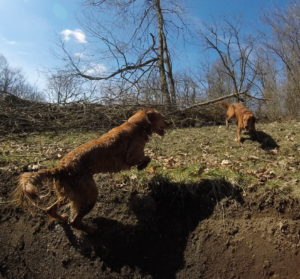Recently we had our first seminar for 2018! One of our training friends, Fanny Gott, came to visit. She’s now come so many times that I’ve lost count – but this was our first time doing an agility seminar. We had two days of agility and then were able to join in for two days of obedience. The agility dogs were all mostly at a similar training level. We were able to accomplish a lot during the two days. As usual – small details help with big picture successes.
 Tonks ended up working throughout the seminar. We came away with a whole list of things to work on. We also have the additional structure of an online class to help us with all those pieces. She’s at a funny stage of her training where she knows a lot of agility skills but is not fluent enough to put everything together.
Tonks ended up working throughout the seminar. We came away with a whole list of things to work on. We also have the additional structure of an online class to help us with all those pieces. She’s at a funny stage of her training where she knows a lot of agility skills but is not fluent enough to put everything together.
Some of my thoughts:
We need to work on fluency/stimulus control with her agility cues. Through other training we’ve started a lot of skills. But we don’t have many informational cues that are trained well enough to be useful.
She has a great stay. We used this some on our sequencing days and some on our obedience sessions later in the week. I’ve not trained her much on staying but she just freezes and intently watches me. It does seem she prefers a stand stay which is fine for agility but we’ll need the sit for obedience.
Sometimes she can get scared. I’ve not seen her truly afraid very often. I was really, really surprised when she was scared of a big poodle-mix type dog. The dog wasn’t doing anything unusual but she was very afraid to pass by the crate. Tonks tried to take an easy route to get treats during an activity rather than doing the task. When someone covered the bowl, she was also unsure and later was hesitant to try again with full speed.
Tonks is very sensitive to my motion. I have thought some of our training challenges were about not wanting to look away from rewards. While that may be part of it, she also is very aware of where I am moving. This can be a problem (pulling off of obstacles, getting her to commit) but also an advantage (off course obstacles are less likely).
 I need to think about the kinds of agility we will be doing and the focal points I want to train. Dogs get specific expectations and this can work to my advantage or disadvantage.
I need to think about the kinds of agility we will be doing and the focal points I want to train. Dogs get specific expectations and this can work to my advantage or disadvantage.
Her jumping is a minor problem. I’ve known this for a long time. She rarely knocks bars and it’s not horrible, but she’s not very coordinated and does some crazy things to “save” situations rather than carefully planning. I’ve not felt this was very impacted by jump grid type training in the past, but we have a few more things to try and we’ll see what happens. She looks just as crazy in the woods as in agility so I know it is not a context-specific situation. I loved the tip to look at the take off point and use that to get the desired landing point. This is making some big changes in our training!